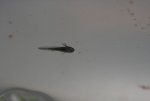ben_tajer
Member
- Joined
- Sep 5, 2004
- Messages
- 915
- Reaction score
- 2
- Points
- 18
- Age
- 35
- Location
- Philadelphia PA/Surrey, England
- Country
- United Nations
- Display Name
- Benjamin Tajer
Foolishly assuming that the united States would be like england where nearly every pet/pond supply store has daphnia for sale at cheap prices I procrastinated in purchasing live foods for my axolotl hatchlings. In a desperate attempt, I ground up some sinking pellets and sprinkled them over the surface of the water hoping for the best. Though it was inefficient, as soon as the pellets started reaching the bottom of the tank, a furious frenzy of bites erupted. I'm currently awaiting a shipment of daphnia, and so I'm only using this as a temporary technique until that shipment arrives. Today I fed them for the third time, and some of the youngsters seem to have developed a new feeding technique:
1. When I start dropping the food, two or three of them come to the surface and take little gulps of air.
2. While they're floating they will swim slowly in reverse causing them to sit just below the surface at a 45º angle pointing towards the surface.
3. From this position they will lunge at the tiny pieces of food floating on the surface.
4. After a while they'll guff (expel the air), and sink back down to the bottom.
Pretty clever for something which barely has a brain (hopefully this will put an end to my room mate's joke that "Darwin cries at the fact axolotls are not extinct"), here's a pic.
The vast majority of the axies still sit at the bottom, five or so will become neutrally buoyant and swim around mid water hunting down pieces of food, only two or three have actually came all the way to the surface.
Dead food isn't all they're getting, the tank has an indigenous population of cyclops and weird little midge things that have colonized my dorm room (they probably came in with the plants). I wouldn't really recomend this method unless in an emergency, upwards of 90% of the food ends up uneaten on the tank floor.
1. When I start dropping the food, two or three of them come to the surface and take little gulps of air.
2. While they're floating they will swim slowly in reverse causing them to sit just below the surface at a 45º angle pointing towards the surface.
3. From this position they will lunge at the tiny pieces of food floating on the surface.
4. After a while they'll guff (expel the air), and sink back down to the bottom.
Pretty clever for something which barely has a brain (hopefully this will put an end to my room mate's joke that "Darwin cries at the fact axolotls are not extinct"), here's a pic.
The vast majority of the axies still sit at the bottom, five or so will become neutrally buoyant and swim around mid water hunting down pieces of food, only two or three have actually came all the way to the surface.
Dead food isn't all they're getting, the tank has an indigenous population of cyclops and weird little midge things that have colonized my dorm room (they probably came in with the plants). I wouldn't really recomend this method unless in an emergency, upwards of 90% of the food ends up uneaten on the tank floor.

